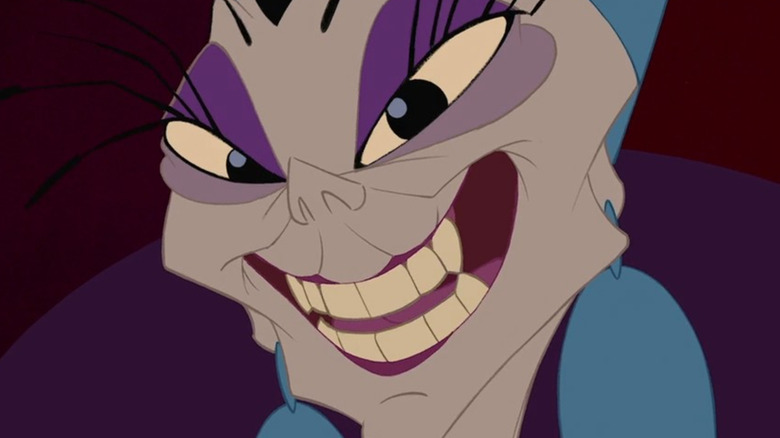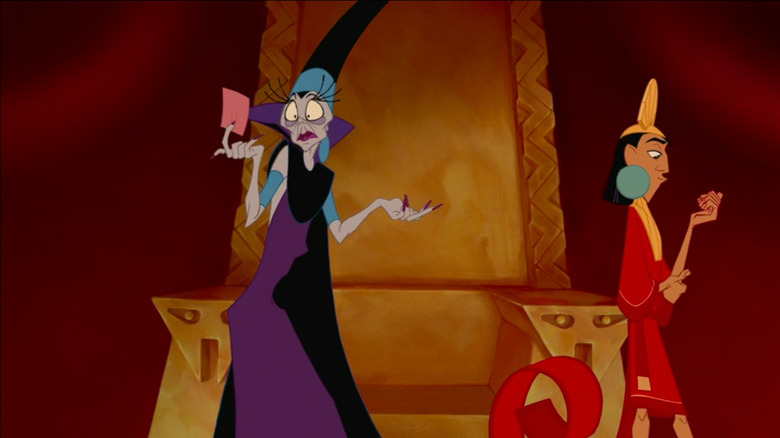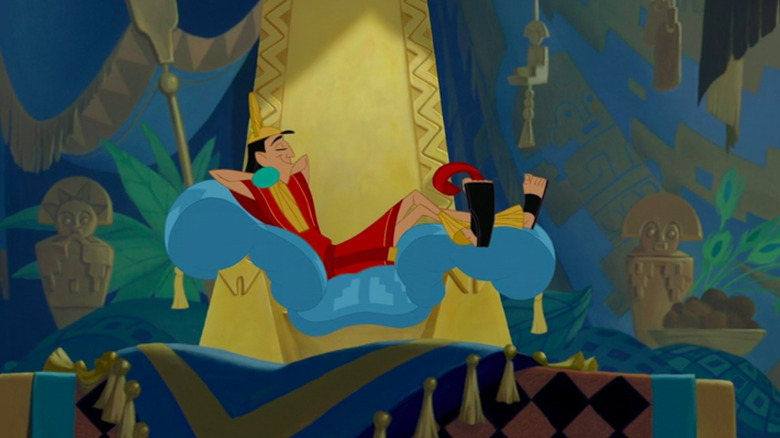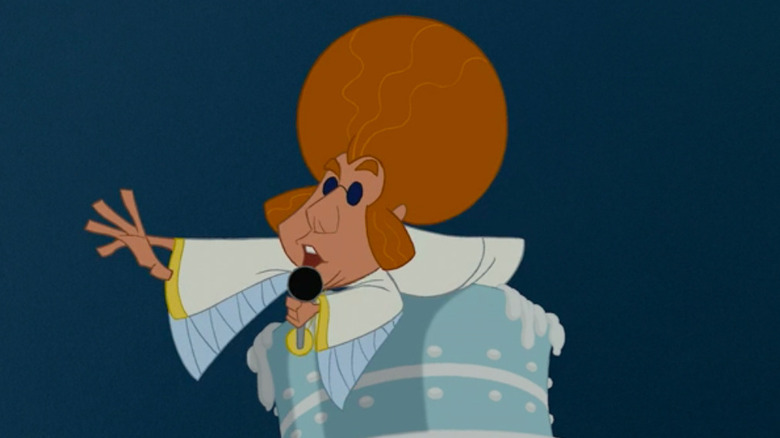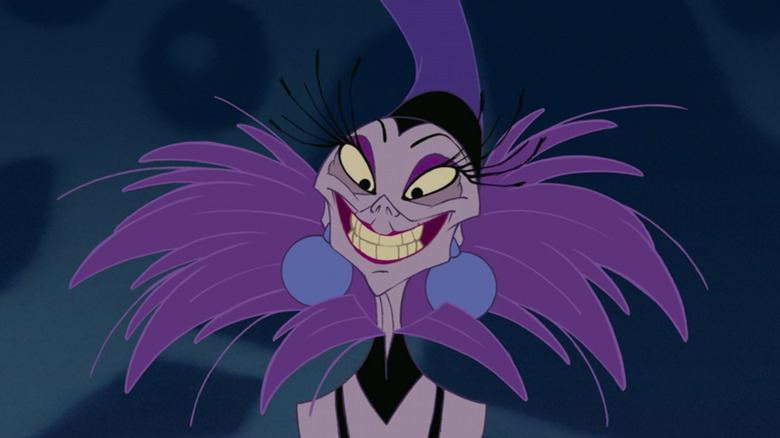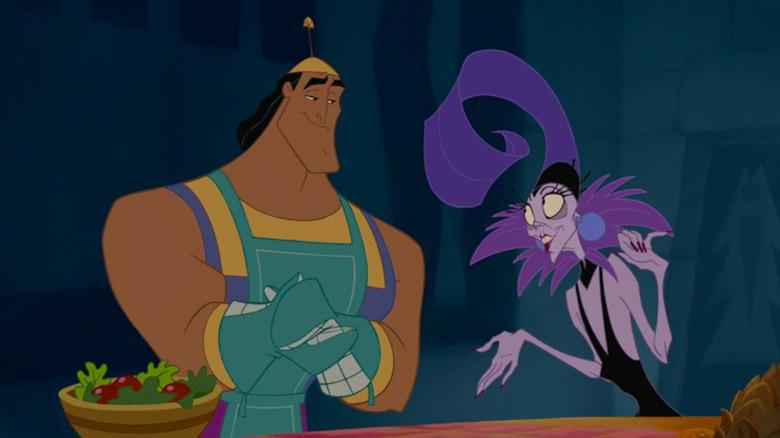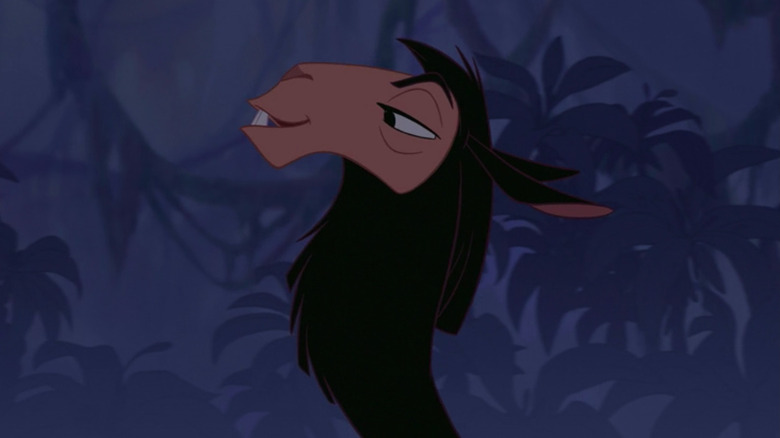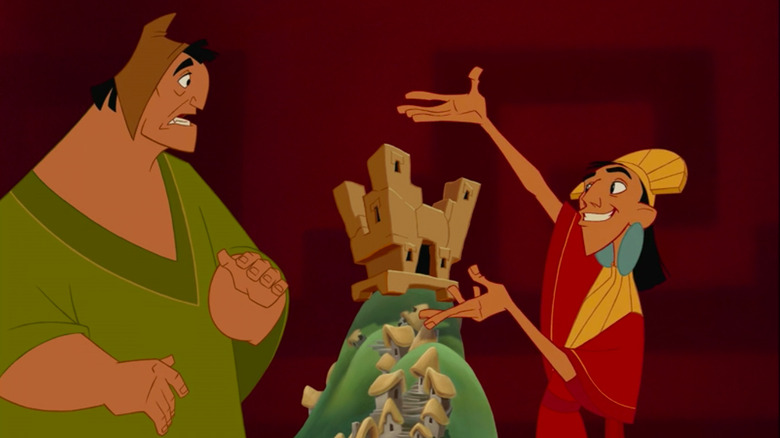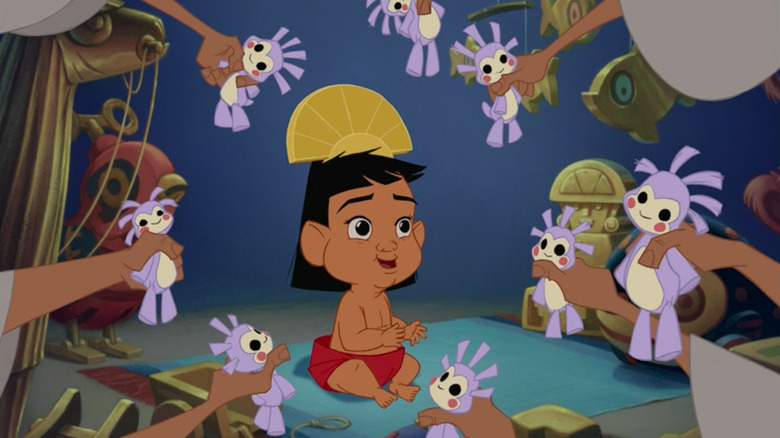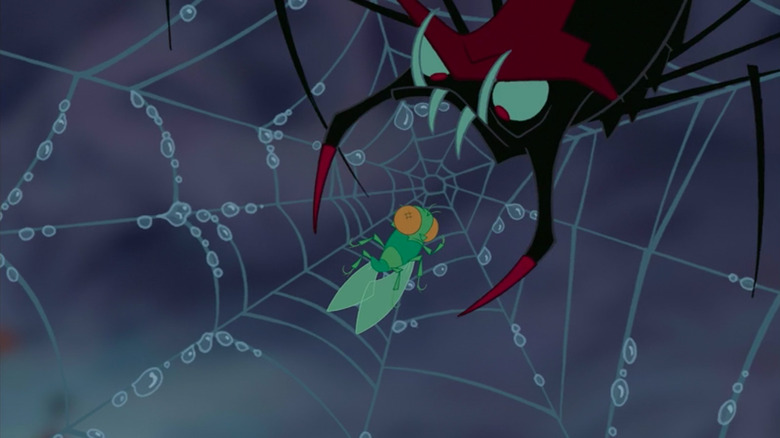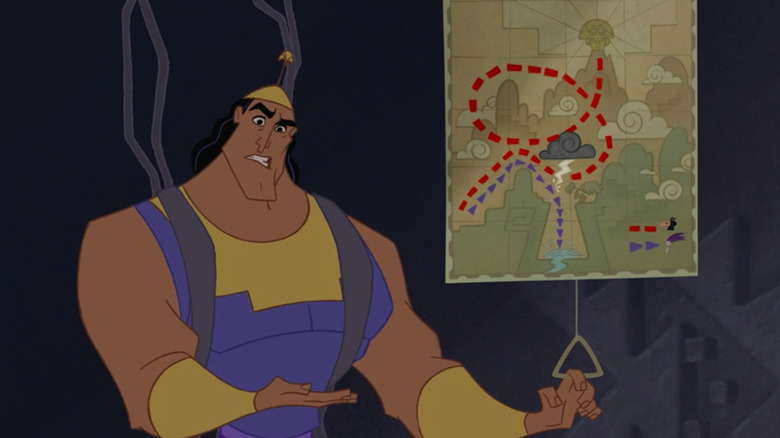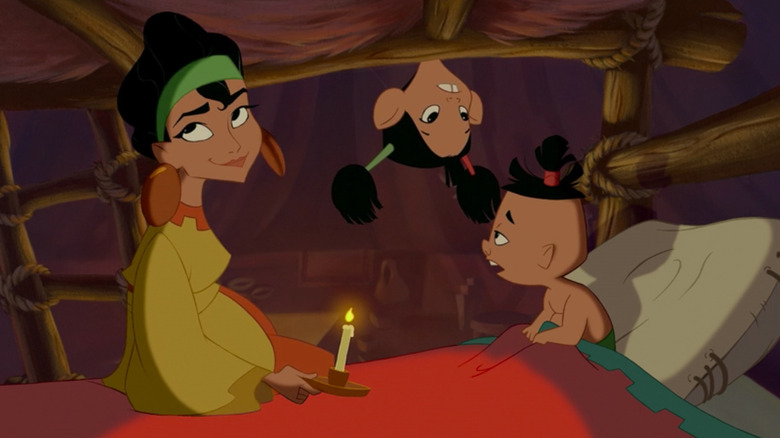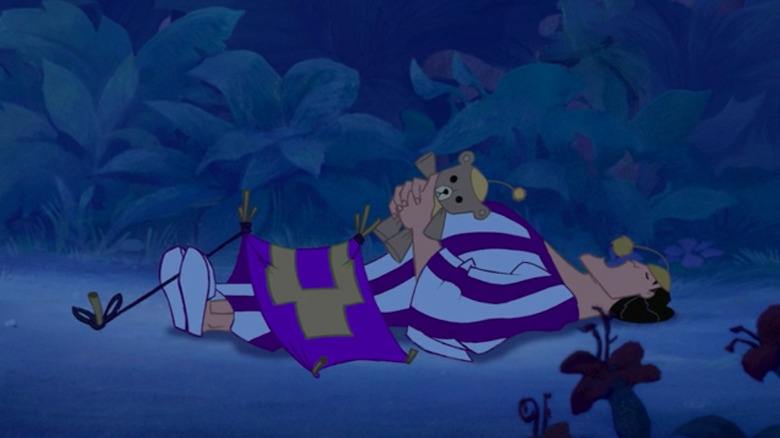Things Only Adults Notice In The Emperor's New Groove
"The Emperor's New Groove" is one of the stranger movies in the Disney vault. Far from the polish, princesses, and prestige the company is known for, the film boasts a loosey-goosey style and irreverent sensibility that make it sillier than a lot of the company's other animated films.
The movie centers on Kuzco (David Spade), a spoiled emperor in long-ago Mesoamerica who's not so much interested in ruling his kingdom as ensuring everything in his life is exactly to his liking. However, when he fires his long-time counselor, the magical potion-maker Yzma (Eartha Kitt), she bitterly turns against him. She plans to kill Kuzco and take the throne for herself. Unfortunately, instead of giving Kuzco a poisoned drink as planned, Yzma's dim-witted but lovable assistant, Kronk (Patrick Warburton), gives him a potion that turns him into a llama. This forces Kuzco to team up with Pacha (John Goodman), one of his subjects, so he can regain his human form and reclaim his throne, all while dodging Yzma, who's still determined to take him out.
The film is full of wry humor that the whole family will enjoy, but there are also quite a few sly jokes and grown-up themes that kids are likely to miss. Here are the things only adults will notice in "The Emperor's New Groove."
If Kuzco wasn't so selfish, the story never would've happened
Kuzco may be arrogant and self-centered when we first meet him in "The Emperor's New Groove," but his egocentrism is so over the top that it's pretty funny. As a result, Kuzco is entertaining to watch — even if being under his rule is a nightmare. Kids may be too charmed by Kuzco's antics to notice what adults surely will: In many ways, Kuzco is the catalyst for his own misfortunes. Sure, Yzma is the movie's antagonist, but up until the point Kuzco fires her, she's content to be his right-hand woman. It's only when he unceremoniously ousts her from her long-held position that she becomes vengeful enough to contemplate murdering him and taking over the kingdom.
Yet, Kuzco's actions toward Yzma are puzzling. Not only is he shockingly callous towards a woman he's known for most of his life, he also makes the decision to let her go because she's making decrees on his behalf. But Kuzco doesn't exactly seem concerned with the troubles of his people, so it's surprising he doesn't feel like Yzma is doing him a favor by taking those duties off his plate. If that weren't enough, even after he turns into a llama, he arrogantly orders Pacha around and refuses to listen to his warnings about the perils of the jungle and Yzma. If Kuzco had a shred of humility, his entire plight as a llama could've been avoided.
The cast would spark controversy today
In 2000, Hollywood was a lot less concerned about representation, diversity, and accuracy in casting. For proof, see "The Emperor's New Groove." The story is set in the time of the Incas in the area that eventually became Peru, which means it takes place prior to the arrival of the Spanish conquistadores. Yet outside of Eartha Kitt, who's partially of Native American descent, none of the other primary actors have an Indigenous background or roots in South America.
While kids are unlikely to think much about the discrepancy between the actors' ancestry and the characters' origins, adults will realize that if the movie were made today, its cast would better represent the region in which the story takes place. Nowadays, movie studios often go out of their way to make sure their casts are representative of their stories' geographic setting, and when they don't, audiences often respond with angry protests. Sure, it could be argued that there aren't a whole lot of actors of Indigenous Peruvian descent to choose from, but in more recent movies like "Encanto," "Turning Red," and "Moana," Disney has cast voice actors that at least have some connection to the setting of the story.
As a result, it's unlikely the company would risk casting men of white European descent like David Spade and John Goodman in these roles today, both to avoid the controversy it would likely cause and to cast actors that would bring more authenticity to the characters.
The opening song is performed by a famous artist
"The Emperor's New Groove" is the rare Disney animated film that isn't a musical. Despite that, it starts with a rousing, Vegas-style number sung by a character Kuzco refers to as Theme Song Guy. While kids will appreciate the idea that Kuzco has someone dedicated to creating theme songs just for him, adults will recognize the distinctive voice behind Theme Song Guy as that of Tom Jones.
Jones' iconic hits include "It's Not Unusual," "She's a Lady," and "What's New, Pussycat?" On top of that, he's often associated with his signature look of tight jeans and a partially open shirt, as well as his frequent performances in Las Vegas. That makes him the perfect choice to sing the theme song, as Jones' image fits perfectly with all the flamboyance and razzle-dazzle of this musical introduction to Kuzco's world. Plus, whether viewers recognize Jones' voice or not, the singer's enthusiastic delivery helps make the movie's opening moments all the more rousing.
The voice behind Yzma belongs to a one-time Batman villain
Kuzco may claim that Yzma is "scary beyond all reason," yet despite her, er, mature (but oh so glamorous!) appearance, Yzma is strangely appealing. It's a quality that can largely be attributed to actor Eartha Kitt, who uses her singular voice to make Yzma hilariously eccentric even when she's scheming to kill Kuzco. No matter how dastardly she gets, the relish with which she states her selfish concerns and ridiculous plans makes her one of the best parts of the film.
Kitt gained legions of young fans for her work as Yzma, a role she reprised in the follow-up film "Kronk's New Groove" and the TV show "The Emperor's New School," which she won two Emmys for. However, kids may not realize that Kitt had a long career in show business well before she became a Disney villain, and even many adults may not be aware of her extensive background as a singer and actor. However, they're likely to be familiar with her most well-known songs, "C'est si bon" and "Santa Baby." Plus, kids would probably be tickled to learn that over three decades before she became Yzma, Kitt played the enduringly popular Catwoman in the third season of the 1960s "Batman" TV show.
There's probably something not-so-professional going on between Kronk and Yzma
Throughout "The Emperor's New Groove," Kronk willingly does Yzma's bidding — except when he has an attack of conscience and has to consult with the angel and devil that periodically show up on his shoulders. Yet, while the movie only shows Kronk acting as Yzma's henchman, adults may notice that there are a couple places in the story that subtly indicate the pair's relationship may not be strictly professional.
First, when Kuzco introduces Yzma, his voiceover notes that Kronk is the latest in a long line of assistants that she regularly switches out every 10 years or so. Then at dinner, while Kuzco and Yzma are waiting for Kronk to mix and serve their drinks, they awkwardly discuss the subject of Kronk, with Kuzco subtly implying that he may be a bit... young for Yzma. While kids may not pick up on the subtext behind these moments, adults will recognize that Kuzco's interest in Kronk's age and Yzma's penchant for periodically replacing her old assistant with a newer model has nothing to do with their performance as her sidekick.
Instead, it's implied that Yzma hires younger men for the role specifically because of their ability to perform their unofficial duties during the pair's alone time together. It's this aspect of Yzma's relationship with Kronk that causes Kuzco to question their age difference.
The choice to turn Kuzco into a llama is representative of the movie's setting
The bulk of "The Emperor's New Groove" revolves around Kuzco's adventures after he's turned into a llama. We discover later in the film that Yzma has potions that can turn a human into everything from a whale to a kitten to a bear to a lion, but the filmmakers' choice to turn Kuzco into a llama isn't coincidental. Kids may not think too much about Kuzco's newly fuzzy form, but adults will know that Kuzco is turned into a llama at least partially due to the region in which the story takes place.
Llamas are native to South America and have become a big part of Peruvian culture. That's because llamas were essential beasts of burden during the Incan Empire, exactly where and when the movie takes place. As a result, Kuzco's transformation into a llama enables him to fit into the environment better than he would have had he become a non-native animal. If nothing else, being a llama is better than being poisoned — at least it gives Kuzco the time he needs to reclaim his lovely human visage, something he wouldn't have had if Kronk had chosen the correct potion from Yzma's expansive stash.
It's the rare Disney movie that addresses classism
Disney's animated movies often focus on royals and their servants. But instead of questioning how class impacts these characters, the films depict the wealth gap between the aristocracy and everyone else as totally normal and natural. For example, in "Beauty and the Beast," the Beast's servants never stop serving him even though it's his fault they were all turned into clocks and candelabras. In "Frozen," Anna and Elsa don't have to concern themselves with making a living because their royal positions are never questioned. In fact, once Elsa learns to manage her powers, she becomes a beloved ruler ... even though it seems the kingdom of Arendelle ran itself for years while she was isolated in her castle.
However, "The Emperor's New Groove" doesn't shy away from exploring how class impacts who we are and what we can do. Early in the movie, a peasant begs Yzma for help to feed his family, and Yzma callously dismisses him. Later, Kuzco summons Pacha to his palace to ask him about his hilltop village, only to reveal he plans on evicting Pacha's community and building a large palace (complete with a water slide) in its place. While Kuzco is completely oblivious, Pacha is flabbergasted, demonstrating Kuzco's aristocratic entitlement and Pacha's working-class helplessness. While kids may not recognize the difference between this movie and other Disney films, adults will know it's the rare Disney film that doesn't depict the divide between classes as okay.
The plot subtly speaks to the dangers of spoiling children
While it's clear from the first moments of "The Emperor's New Groove" that Kuzco is self-obsessed and lacking in empathy, the plot also indicates he's not entirely responsible for his attitude. In fact, the movie suggests that Kuzco was spoiled rotten from an early age, a reality that would cause him to feel like the world revolves around him.
In the film's one flashback to Kuzco as a baby, the young emperor is shown breaking his stuffed animal and then immediately being presented with several new ones before he can experience any real disappointment. Plus, Kuzco's circumstances haven't changed much since then, as he's shown having his every whim met by a never-ending flow of servants in the movie's present day. While kids may understand that Kuzco's a self-important egomaniac — albeit a funny one — adults will recognize that the movie points to the negative consequences of meeting a child's every need.
The disturbing reason that fly can speak
When Kuzco learns he's been turned into a llama, his initial instinct is to return to his palace so Yzma can turn him back. He never considers that Yzma was the only one who had the power to transform him in the first place. However, he doesn't get far before realizing his role as emperor doesn't make him quite as untouchable as he imagined, especially in llama form. Kuzco witnesses the law of the jungle firsthand when he sees a fly get trapped in a spider's web. Only there's something different about this fly: Kuzco can hear it calling for help and not because it emits panicked buzzing but because it actually says "help me" in English.
While kids may not think too much about this — after all, kids' movies are full of talking animals — adults may conclude (aside from it being a reference to a famous Vincent Price movie, "The Fly") that the insect's ability to talk indicates his origins are less than natural. The only other non-human that can speak English in "The Emperor's New Groove" is Llama-Kuzco, and the only reason he can speak English seems to be that he was originally human. That indicates the fly likely used to be human too, and given Yzma is the only one in the movie who can create potions that change an individual physically, Yzma is probably the one who changed the fly from a human into its current form. Yikes!
The movie includes some amusing references
"The Emperor's New Groove" is loaded with pop culture references and absurd meta jokes — many of which only adults will notice. For example, the restaurant that Pacha and Kuzco visit on their way back to the palace uses a logo that's designed to resemble the iconic mascot for the Bob's Big Boy restaurant chain.
Additionally, when the pair finally make it back to the palace and into Yzma's "secret" lair, they discover her potions are organized in a very particular order — first lions, then tigers, then bears. And that's when they're interrupted by Yzma who purrs "oh my" behind them. Yes, although the delivery doesn't match that of Dorothy and her friends, this is a "Wizard of Oz" joke, with Kuzco, Pacha, and Yzma coming together to create their version of the famous chant "lions and tigers and bears, oh my!"
Finally, in the big climax, it's revealed that Yzma and Kronk made it back to the palace before Kuzco and Pacha, even though our heroes had a head start. When Kuzco asks how they got there first, Kronk agrees it doesn't make sense and pulls out a map that shows both duos' paths back to the palace. Adults will notice that the map shows Yzma and Kronk fell into a hole on their journey. Yes, this is a literal plot hole, and the illustration is the movie's way of acknowledging that there's no real reason the pair got to the palace first except that the plot required them to.
Chicha may be the most realistic mom in Disney history
Disney animated films aren't exactly known for their positive treatment of mothers. From "Snow White" to "Beauty and the Beast," Disney movies tend to feature characters who grew up without a mom, usually because she died early on. If that weren't bad enough, this absence often leaves an opening for another woman to become the character's inevitably evil stepmother, resulting in further harm and humiliation.
In one way, "The Emperor's New Groove" continues the tradition, as it indicates that Kuzco was orphaned as a baby, even though his upbringing was anything but hard. However, the movie also includes a living mother in the form of Pacha's wife, Chicha (Wendie Malick), and she may be one of the most best examples of a mother and wife in an animated Disney movie. Even though Chicha is a tertiary character, her personality shines through in the brief screen time she gets. Even though she clearly loves her kids, she also merely tolerates their shenanigans. Plus, she's not above enlisting them in the odd scheme when she needs to. Adults who have experience as parents and caretakers of little ones will notice this makes her seem more fully rounded and human than almost any other mother that's appeared in a Disney film.
The Emperor's New Groove contains a couple of very adult jokes
The best kids films appeal to adults and children alike, but "The Emperor's New Groove" goes out of its way to entertain adults by including a couple of jokes that are strictly for mature audiences. First, when Yzma and Kronk camp out for the night during their journey to find Kuzco in llama form, Yzma gets a giant tent to slumber in. On the other hand, Kronk is relegated to a tiny tent that's only large enough to fit over his hips. That means it covers up a very specific area of his body in a sight gag that adults will understand makes the phrase "pitching a tent" literal.
Plus, when Yzma confronts Kuzco and Pacha in her lair later in the film, she threatens them while pulling up the side of her dress. Kuzco and Pacha are absolutely terrified at her actions and then overwhelmingly relieved when she reveals she has a large knife strapped to her thigh. While kids probably won't know why Kuzco and Pacha aren't scared of the knife, adults will realize that the pair were more worried that they'd catch a glimpse of a very specific part of Yzma's anatomy. Thankfully, these are the kinds of gags that, if kids notice them at all, adults can simply feign ignorance or inform kids they'll have to wait until they're older to understand them.
